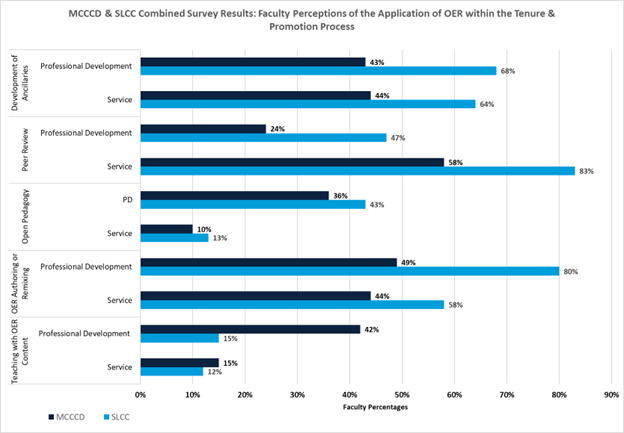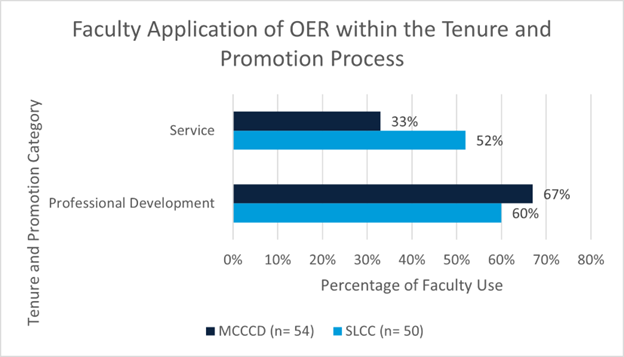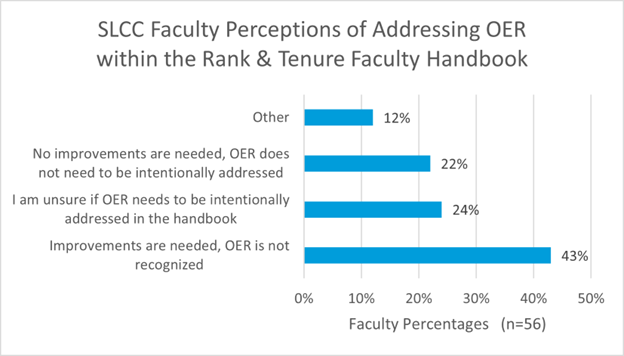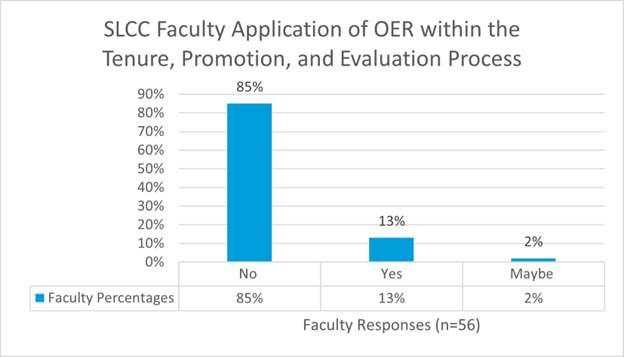22 Illuminating Pathways: A Comparative Exploration into Faculty Perceptions and Practices of Open Education in the Tenure and Review Process at Two Community Colleges
Lisa C. Young and Andrea Corbett Scott
Case study writers:
- Lisa C. Young, PhD Faculty Administrator, Open Education & Innovation
- Andrea Corbett Scott, OER Coordinator, Office of Learning Advancement
Institution: Maricopa County Community College District (Associate’s Colleges: High Transfer-Nontraditional) and Salt Lake Community College (Associate’s Colleges: High Transfer-Mixed Traditional/Nontraditional)
Type of intervention: An evaluation of how open education is applied in the tenure and review processes at two community college systems.
Background
Open Salt Lake Community College (SLCC) and Open Maricopa (OM) are two large community college OER systems that have nearly 10 years of advocacy and strategy around open education. The Maricopa County Community College District (MCCCD) is a 10-college system situated in the Phoenix metropolitan area, currently serving approximately 80,000 students. The OM (formerly Maricopa Millions) program was founded in 2013. SLCC is Utah’s largest college serving more than 60,000 students online and across 10 campus locations in the Salt Lake City Valley. Open SLCC is a large OER program with 11,730 OER sections offered since 2013. This chapter will provide an overview of the tenure processes at both institutions, their similarities and differences, the culture surrounding OER, and how it applies to the tenure process. Highlights include faculty perspective and experiences with leveraging OER for the tenure process (what worked and hasn’t).
Approach
Open SLCC and OM have similar processes for tenure and promotion. At SLCC, tenure-track faculty are the rank of assistant professors and serve a six-year pretenure probation cycle. During the probation period, tenure-track faculty are mentored by an administrator and the faculty evaluation sitting committee members through the Tenure-Evaluation Process (TEP), which is a component of the Formal Faculty Evaluation Process (FFEP).
According to the SLCC Full Time Faculty Handbook for Compensation and Workload Appendix 4/5 [PDF], the Formal Faculty Evaluation Process “provides feedback from department peers, department administrators, and students to improve faculty performance and enhance student learning” (p. 35). The FFEP consists of three assessment areas: Teaching, Professional Activity and Development, and Service. The SLCC Full Time Faculty Handbook for Compensation and Workload Appendix 4/5 notes how distribution areas are weighted: “SLCC faculty prioritize teaching and student learning over the other two areas of responsibility (consistent with SLCC Mission and USHE R485)” (p. 47).
Residential full-time faculty at the MCCCD are in probationary status for a period of five years. During this time, they are engaged in the Individual Development Plan (IDP) and Peer Assistance and Review (PAR) process. Per the Faculty Agreement (2022) [PDF], “the IDP process is intended to provide significant professional growth and development for the Probationary Faculty member in an environment of support and encouragement from Faculty Developers, Department/Division Chairs, Faculty Mentors, Instructional Administrators, and others” (p. 84). The IDP is an e-portfolio of sorts in which the probationary faculty document activities from the academic year in relation to three key areas:
- Instruction or primary work activity
- Service to department/division, college, and district
- Professional development
Here is an overview of the process for Open SLCC and Open Maricopa:
- Pre-tenure probation period (6 years for Open SLCC and 5 years for Open Maricopa)
- Mentorship
- Committee evaluation team
- Assessment areas
- Teaching
- Professional activity and development
- Service
- Evaluations
- VPAA/dean
- Associate dean/chair
- Sitting committee (selected by assistant faculty)
- Standing committee
- Student evaluations
- Self-evaluation
- Steps
- Goal setting
- Committee selection
- Teaching observations
- Professional portfolio
- Performance evaluation meeting
- Notification of renew, renew with concerns, nonrenewal
Assessment Areas
Faculty engaged in the tenure and promotion processes—FFEP and PAR—are able to provide evidence of the three assessment areas. Some ways OER can be leveraged in these assessment areas are as follows:
- Teaching
- The use of OER in the class
- Use, remix, or development of OER content
- Open pedagogy
- Professional activity and development
- Participate in scholarship of teaching and learning with OER emphasis
- Attend conference(s)
- Complete training
- Conduct OER Research
- Service
- Serve as an OER department coordinator
- Join an OER committee or board at the institution or within the OER community
- Perform peer review
OER adoption was the driver of growth in the early years of program development. As the programs evolved, additional areas of expansion in open scholarship emerged, including faculty interest in OER publication and open educational practices. At SLCC, the Pressbooks publishing platform, Open SLCC, was introduced in the spring of 2020, increasing faculty interest in authoring and remixing OER content. Similar to SLCC, MCCCD introduced Maricopa Open Digital (MOD) Press, and efforts have shifted focus “to revise, remix, enhance and expand upon the open content in the Maricopa Millions catalog.”[1]
Open educational practices, including open pedagogy, have grown organically at SLCC, with a few faculty members participating in open pedagogy projects. MCCCD has taken an intentional path for growth and currently participates in the UN SDG Open Pedagogy Fellowship, which invites “faculty to work with their colleagues and students to impact change via open pedagogy and community engagement.”[2]
Teaching is still the primary category faculty document OER work within the tenure, promotion, and evaluation process; however, both institutions have observed a significant shift in faculty highlighting open scholarship within the Service and Professional Development categories.
Results
While OER can be a catalyst for faculty recognition, how OER is officially recognized at the institution level is indistinct. To gain further clarity on faculty perceptions and experiences of OER within the tenure and process, SLCC and MCCCD partnered to launch a survey. The target population included full-time faculty at both institutions. In the SLCC survey, 22 percent of full-time faculty members participated, with 55 percent associate professors, 25 percent assistant professors and 16 percent professors (tenure rank), 3 percent instructors, and 1 percent associate professor/coordinator participating in the survey, including representation from 29 academic departments. For the MCCCD survey, of the full-time, residential faculty that participated, 53 percent were probationary faculty (currently doing PAR) and 47 percent were appointive (completed PAR) with nine fields of interest represented.
In the Faculty Perceptions of OER within Tenure and Promotion Process surveys at MCCCD and SLCC, faculty were asked to categorize OER activities based on application experiences and perceptions. In the SLCC survey, faculty were provided three choices, including Teaching, Service, and Professional Development. The MCCCD included Service and Professional Development. For this case study, only the Service and Professional Development categories were analyzed in Charts 1 and 2.
Chart 1 compares MCCCD (n = 54) and SLCC (n = 59) faculty survey responses. Faculty were asked the following question: Which categories within tenure and promotion do you feel the OER activity on the left best associates with? Select all that apply.

Chart 2 displays a comparison of the MCCCD and SLCC faculty survey results regarding the application of OER within the tenure and promotion process. Faculty were asked the following: “Have you documented OER related work in any of the following categories for your Tenure and Promotion Evaluation? Select all that apply.”

Faculty at both SLCC and MCCCD shared that teaching using OER, and adopting OER were aligned with their instructional/teaching duties. They shared that it could also qualify as professional development if they were learning about OER as they used it. Faculty at these institutions shared,
- “Since this is focused on teaching, it fits best in the teaching category, but if other activities are involved, such as getting trained on the material or serving as course lead for a course using OER content, it could also involve professional development or service.”
- “Choosing to use OER and teach with OER in your classrooms is not related to developing as a professional anymore that choosing a different publisher textbook would be considered professional development. I see the role of teaching as our job regardless of the materials we use.”
- “Requires modifying teaching styles and content.”
In regard to authoring and adapting OER, faculty at the two colleges indicated that it was both service and professional development, as well as instruction/teaching. The sentiments shared were captured in the following quotes:
- “This fits under teaching. Since you use this in your teaching, it is part of how you are making your teaching inclusive by being affordable; you can embed OER resources into your Canvas sites. If you share your resources with other instructors, then it could also be service, and if you had to learn how to develop/use these resources, this qualifies under professional development.”
- “I saw my purpose in developing a course with OER content as providing a service to others who would use the course more than improving my own teaching, though it probably had a greater impact on the latter.”
Faculty felt strongly that open pedagogy was primarily in the teaching category, sharing,
- “Open pedagogy seems to be…pedagogy…which is teaching philosophy and technique.”
- “Developing pedagogy falls best under “Teaching.” However, developing open pedagogy could potentially require some research and learning. Therefore, it could also fall under “Professional Development.”
The topic of peer review of OER materials garnered strong support as a form of Service and could also be aligned with Professional Development. Faculty at the institutions shared,
- “This associates with service to other faculty (being reviewed) and allows faculty to continue broadening perspective of their field and staying relevant with new material.”
- “I selected Service and Professional Development for this area because someone who reviews materials is going above and beyond the basic requirements as a faculty member. Additionally, as a peer reviewer, you gain important skills and perspective.”
Faculty were nearly evenly split in regard to whether the development of OER ancillary materials was service or professional development, sharing,
- “The creation of OER materials of any kind, including ancillary materials that support teaching and learning, are publishable and shareable, so I count this as Service. This is especially true if I am able to post them in multiple locations.”
- “The development of OER ancillaries, such as additional learning materials, activities, and assessment, can help to further engage students and enhance their learning experience. Using open resources provides a great way for educators to develop meaningful ancillaries that can be used to supplement their courses without incurring high costs. These ancillaries should be designed in a way that encourages active learning and allows students to better understand the material.”
- “You can still be teaching with OER even if you are not using an OER text. There are many other free online sources that we review and include in our courses. This takes a lot of time and effort to find good resources; check them and then include them in your teaching practices, so this falls under all three categories.”
SLCC’s Full Time Faculty Handbook for Compensation and Workload Appendix 4/5 provides instructions and guidance on the process for SLCC faculty. SLCC faculty are evaluated by three standards: “Standard Professional Performance (expected of all full-time faculty), Exceeds Standard Professional Performance, and Below Standard Professional Performance.”[3] In the service category of the handbook, a list of descriptive examples of exceeding standards is included. While the list is not exhaustive, OER is not included.
In the SLCC Survey Perceptions of OER within the Appointment, Rank, Tenure, Promotion, and Evaluation Process, the following question was asked: “OER is not mentioned in the language of the Faculty Handbook. How do you feel about intentionally addressing OER within the Rank & Tenure (Appendix ⅘) portion of the Faculty Handbook?” Chart 3 highlights 43 percent of the survey participants selected “Improvements are needed, OER is not recognized.”

The SLCC survey further explored faculty experiences with justifying OER work within the Tenure, Promotion, and Evaluation process by asking, “Have you experienced any difficulty justifying your OER work or projects to your sitting committee, Associate Dean / Chairs, or Dean?” Chart 4 highlights the total survey participants’ responses with the following: 85 percent were no, 13 percent yes, and 2 percent maybe.

Recommendations
Based on the SLCC Faculty Perceptions of OER within the Appointment, Rank, Tenure, Promotion, and Evaluation Process Survey results, it is clear that improvements can be achieved.
- Additional institutional conversations will take place to evaluate if adding language to the faculty handbooks is the best course of action.
- The Open SLCC team will develop additional materials to raise awareness for OE applications within the tenure, promotion, and evaluation process.
For OM, there is an opportunity to promote the inclusion of OE work in the IDP for new faculty as well as existing faculty.
- This can be done in the new faculty orientation process, the OM website, and in materials provided when faculty participate in faculty development concerning OE and receive funding for adaptation and development of OER.
Image Description
| Activity | Percent of Faculty Who Classify Activity as Professional Development | Percent of Faculty Who Classify Activity as Service |
|---|---|---|
| Development of ancillaries | MCCCD 43%
SLCC 68% |
MCCCD 44%
SLCC 64% |
| Peer review | MCCCD 24%
SLCC 47% |
MCCCD 58%
SLCC 83% |
| Open pedagogy | MCCCD 36%
SLCC 43% |
MCCCD 10%
SLCC 13% |
| OER Authoring or Remixing | MCCCD 49%
SLCC 80% |
MCCCD 44%
SLCC 58% |
| Teaching with OER Content | MCCCD 42%
SLCC 15% |
MCCCD 15%
SLCC 12% |
- Maricopa Open Digital (MOD) Press Development Grants—Funding for 2020–2021: OER @ Maricopa (Maricopa Open). Accessed June 1, 2023. ↵
- “UNSDG Open Pedagogy Faculty Fellowship.” Maricopa Community Colleges. Accessed June 5, 2023. ↵
- “Appendix 4/5 Faculty Appointment, Rank, Tenure, Promotion and Evaluation.” Full Time Faculty Handbook for Compensation and Workload. Accessed June 5, 2023. ↵
